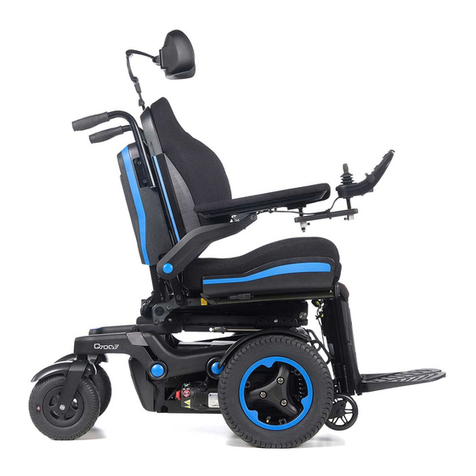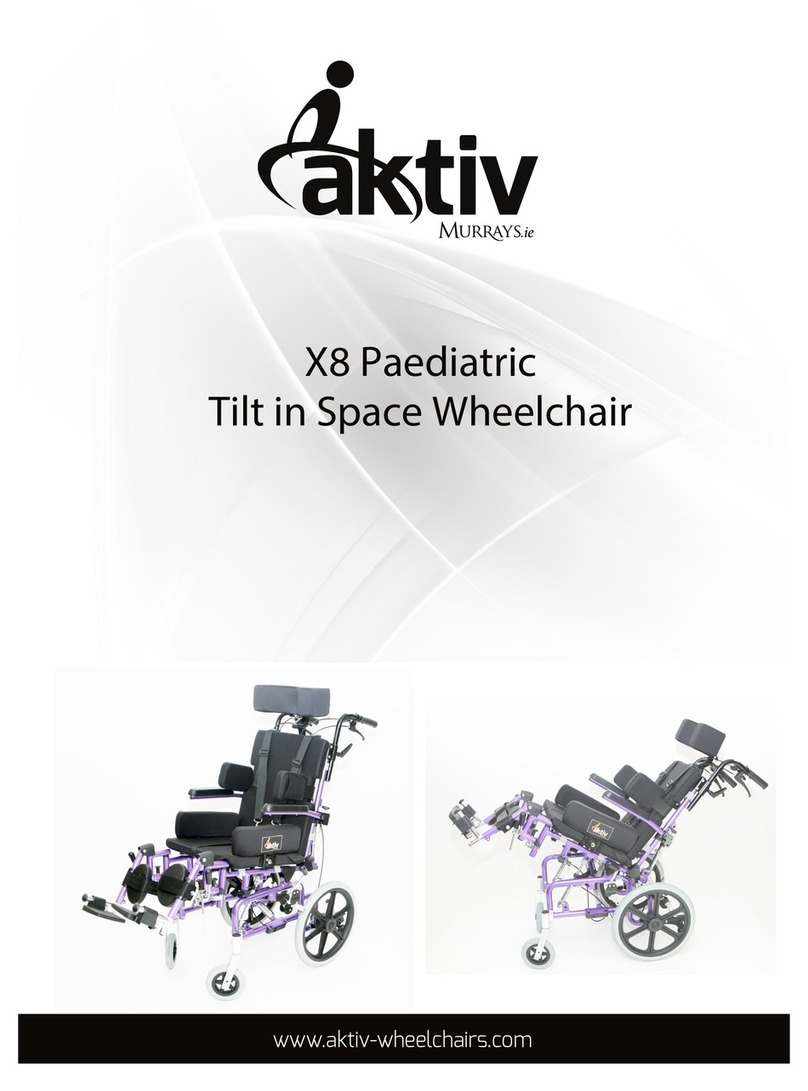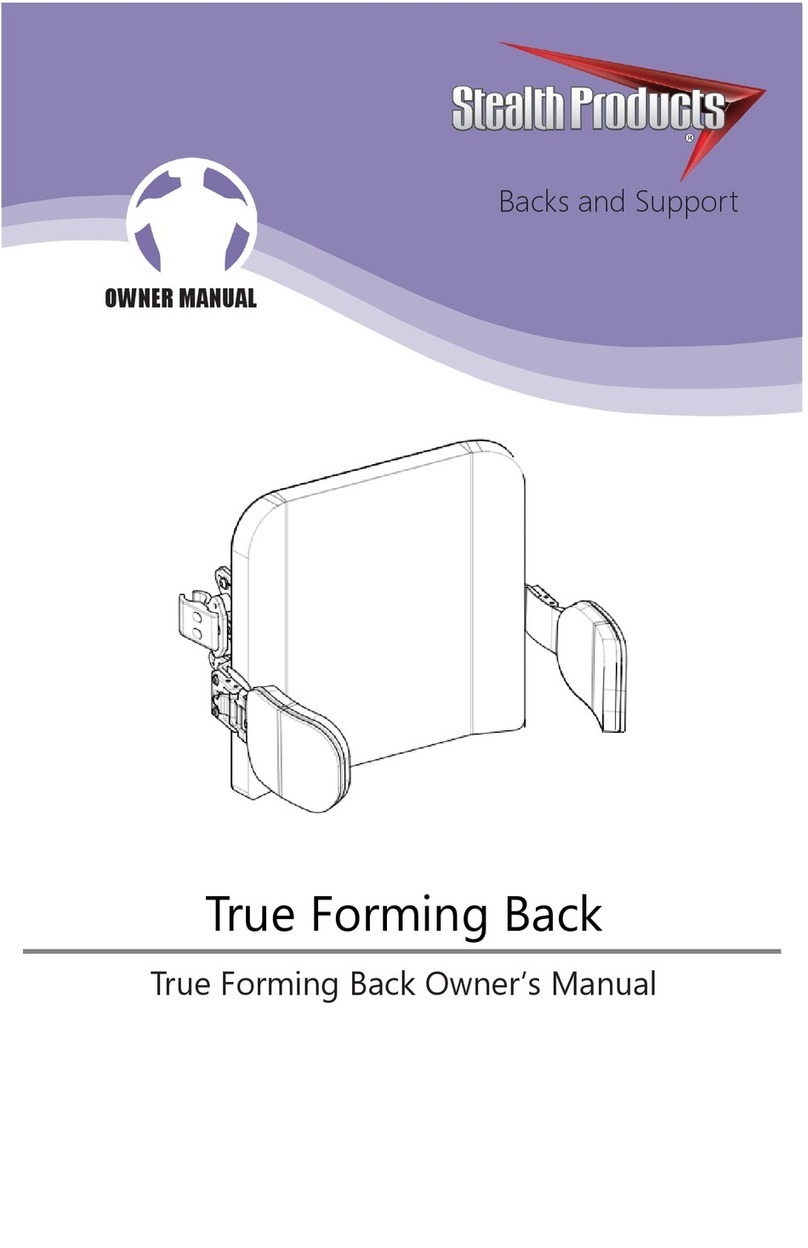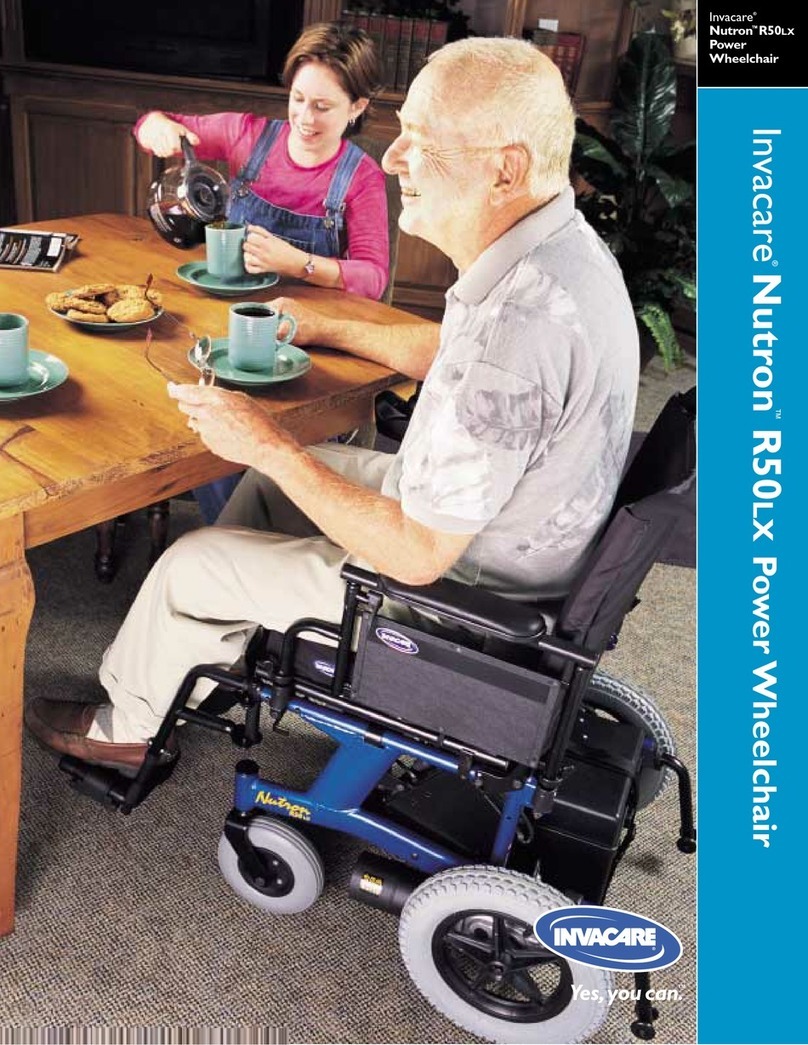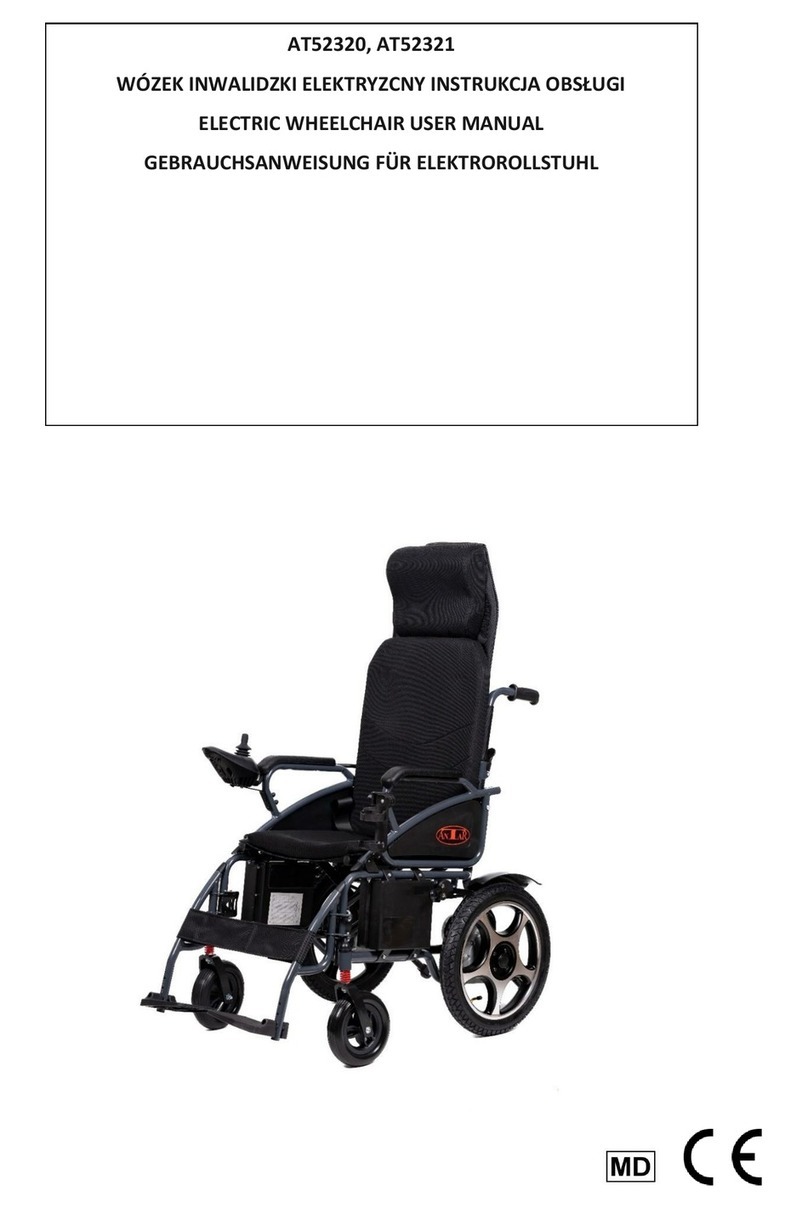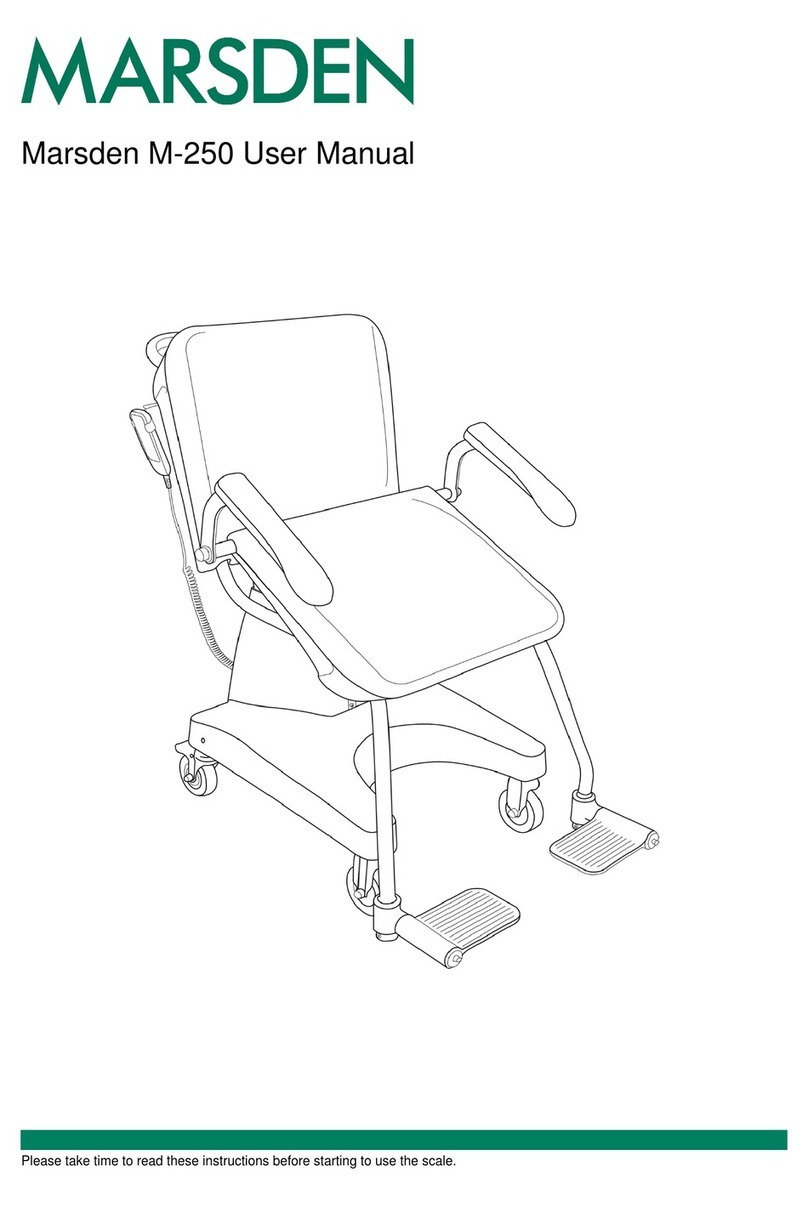Foldawheel LLOYD LEO II User manual

V2.0
User Manual
LLOYD LEO II
w h e e l c h a i r 8 8 . c o m
F o l d a w h e e l

TABLE OF CONTENTS
PARTS INTRODUCTION
01
Title Page
Parts Introduction 01
Safety Tips 02 - 03
Set Up Upon Arrivals 04 - 05
Adjustment 06 - 07
Operation 08
Storage 09
Maintenance 10
Contact Us 11
01. Backrest
02. Gas Spring-release Lever
03. Rear Wheel
04. Handrim
05. Wheel Lock
06. Quick-release Fork
07. Caster
08. Armrest
09. Armrest-release Lever
10. Safety Belt
11. Seatrest
12. Knee Support
13. Gas Spring
14. Heel Strap
15. Footrest
01
02
03
04
05
06
07
10
13
12
14
15
08
09
11

02
SAFETY TIPS
1-1.1. Stand up stresses your body in ways you may not be used to. Therefore we
recommend you consult your doctor or physical therapist before using the
stand-up wheelchair.
Check tire pressure weekly (pneumatic tires) , Because it will aect the grip of the
wheel locks. Wheel locks are not designed to slow the wheelchair down when it is
moving. Wheel locks hold the wheelchair in place when it is at a complete stop.
Always set both wheel locks when entering or stand-up or leaving the wheelchair.
Do not mount the quick release rear axles with the release button positioned inside
the frame. If the release button is inside the frame, the wheels will release.
1-1.2. Before stand up it is absolutely vital that the knee support, safety belt and
Chest belt are xed correctly.
1-2. Wheel Locks
Marking any unauthorized modications or using parts not supplied by technical
personnel, may change the wheelchair structure and create an unsafe condition
voiding the warranty.
1-4. Modifications
1-3. Rear Wheel
1-3-1. Quick Release Axles
Check pneumatic tires weekly for proper Ination level, listed on tire sidewall.
1-3-2. Pneumatic Tires
Always practice with your Healthcare professional or attendant. Before attempting to
negotiate cubs, Inclines or ramps alone.
1-3-3. Curbs, Inclines And Ramps
Warning : Doing a ”wheelie”(tilting the wheelchair Backward to its balance point)
can be dangerous.
- Before using the stand up wheelchair you should supposed to be familiar with
the operation and the function.
- Use only standard household and hard even ground. Not use in the ground of
dripping wet.
- In case of staircase, the stand up wheelchair must be carried by two persons.
- When rides or leaves the stand up wheelchair , should not put the foot on the
footplate, to avoid the dangers.
1-1. Standing
Attention :
Warning : Maximum weight limit should not exceed. HSHX Series - 250 lbs.(120 KGS)
It is important for you to develop a safe. Technique that is suitable to your abilities.

03
SET UP UPON ARRIVALS
-Standing wheelchair Heel strap &safety belt
-Knee Support
-User manual , tool and oil pot
-Option as ordered
2-1. The Original Package Contains The Following Components.
-Remove any transport straps or transport guards.
-Depress Quick-release axles can be assembly rear wheel(P1)
- Depress Quick-release axles can be assembly front castor. (P1A)
-Grasp the wheelchair at the backrest and pull backward up to stop. (P2~4)
2-2. Unfolding The Standing Wheelchair, Please Proceed As
Attention :
P1 P1A
P2 P3 P4

04
ADJUSTMENT
Should you require adjustments and alterations to the mechanism of the wheelchair,
or any maintenance work, please contact qualified technicians.
- Push the gas spring release lever let the wheelchair frame rise over
the rear wheel.(P5)
- After loosening the left(right)both side screws the seat depth can be adjusted
using the different holes at 1”distance.(P6~8)
- Retighten the left(right)both side screws.(P9 &10)
Theheightofthefootrestisadjustableandshouldbealteredinlinewithyour
bodyproportionstoguaranteethebeststandingpositionpossible.Footrest
adjustmentshouldalsotakeaccountofyourchoiceofseatcushion.(P11~13)
- AfterlooseningthescrewstheFootrestheightcanbeadjustedusingthe
differentholesat1.8cmdistance.
- Retightenthescrews.(nottootight)
3-1. Adjusting The Seat Depth
3-2. Adjusting The Footrest Height
P5 P6 P7
P8 P9 P10
P11 P13P12

05
3-3. Adjusting The Footrest Angle
ADJUSTMENT
3-5-1. Manual Brakes
Note:
Brakes adjustment are based upon the diameter and type of the wheels. After repairing a flat tyre or
in the event of wear of the pneumatic or solid tyre, you may need to adjust the brake(s).
- After release the screws the footplate angle can be adjusted using the different
hole at 3 range incline angle.(P14 & 15)
- Retighten the screws.(P16)
3-4. Adjusting The Backrest Height
3-5. Wheel Lock
- Remove the backrest padded and end cap.(P17 &18)
- After opening the both screws (left & right ),the backrest height can be
adjusted.(P19~20)
- Retighten the screws.
Themanualbrakesaredesignedtosecurethewheelchairduringlongstops.
Theyarenotintendedtoslowdownthewheelchairortobeusedassupport
duringatransfer.Theymustbeoperatedsimultaneously.Inordertobrake,
Thehandle(A)pushinwardtoreleasethebrake(P21).Thehandlepulloutward
tolockthebrake(P22).Oncethebrakesareengaged,thewheelchairshould
notmoveatall.
P14 P15 P16
P17 P18 P19 P20
P21 P22
A

06
3-6. The Knee Support And Safety Belt
ADJUSTMENT
3-6-1. The Knee Support
3-6-2. The Safety Belt
(P25)
The most important safety features of the stand-up wheelchairs are the knee
support &safety belt and chest belt. It is absolutely essential that these be correctly
in place before you attempt to stand up.
The knee support holds the knees in an extended posture and prevents you
slipping out the wheelchair while standing up.
Attach the two triangular clasp of the knee lock support
to the double-head screws on either side of the
wheelchair.(P23)
Center the knee support in front of each knee using
the Velour fasteners, then pull it until it is sitting firmly in
place, just below (not right on) the knee cap and not
too tight.(P24)
P23
P24
- The safety belt holds the waist in place.
-Make sure that the safety belt is secure on the
backrest of velour fasten.
- Close the catch on the safety belt and pull it and not
too tight.
-To release the safety belt. Simply press the red button
in the center of the catch.
- To slacken, hold the catch at a right angle to the belt
and pull.
P25
3-7. The Rear Wheels / Castors
- Thankstothequick-releaseaxles,therearwheels
canbeeasilyremovedandsetbackinplace(P26)
- Depressthereleasebuttoninthecenterofthe
wheel,thenpullofforre-mountthewheel.
- Havingmountedthewheel,pushandpullit
severaltimestoensurethequick-releaseaxlehas
definitelylockedin.
P26

07
ADJUSTMENT
3-8. The Heel Strap(P28)
3-9. Gas Spring
3-10. The Seat Cushion
Note:
Contents under pressure. Do not take apart puncture apply heat or fire.
The gas springs may be adjusted by qualified technician! Please contact your dealer !
Once the knee support, safety belt are fitted correctly you are ready to stand up.
Caution:
Do not bead or stretch the cables leading from the armrests to the gas springs as this may
unintentionally trigger the stand- up mechanism (risk of accident)!
Toremoveandsetbackthecastorstogetherwith
thefrontforks,depressthequick-releaseaxlefrom
underneaththenpullofftheforksorpushtheforks.
(P27)
P27
Thepurposeoftheheelstrapistopreventthelegs
orfeetslippingbackwards.Itisfittedbehindthe
heelsorhigher.Bymakinguseofthevelcro
fasteningitispossibletoalterthelengthof
thestrapandthustoensuretheidealpositionfor
thefeetonthefootrest.Idealpositioningofthefeet
isvitalinensuringagoodstandingposition.
Thegasspringarespeciallydesigntohelpholdyourbodyweightinthebalance.
Withminimalarmwork,i.e.pushinglightlyonthearmrests,youcanstand
yourselfup.Similarly,bypullinglightlyyoucansityourselfbackdownin
yourseat,equallyeffortlessly.Thereisarangeofspringstrengthstosuit
thebodyweightofdifferentwheelchairusers.
Thereisachoiceofvariousdifferentseatcushions,governedbyyourindividual
needs.TheVelcrofastenersfittedtothesurfaceofyourseatshouldallowyouto
attachthemajorityofsetcushionssecurely.TheVelcrofastenerspreventthe
cushionfromslippingoutofplaceevenwhenyouarestandingup.Theheight
ofthefootrestshouldbeadjustedtotakeintoaccounttheheightofagiven
seatcushion.
P28

08
OPERATION
The Knee Support
4-1. Standing
Note:
Before standing up, apply both brakes on the LLOYD LeoII ( HSH2 ). Please beware of parts of
the wheelchair where one might conceivably trap or catch parts of the body when standing up,
in the space between the side panel / armrest and the seat as well as in the pivot of the side
panel / armrest. Be sure to protect yourself and accompanying persons from possible injury.
The most important safety features of the stand-up wheelchairs are the knee support &safety
belt and chest belt. It is absolutely essential that these be correctly in place before you attempt
to stand up.
Standing up stresses your body in ways you may not be used to. For this reason,
please consult your doctor or physical therapist before using the standing
aid to make sure you do not suffer from any conditions (e.g. strong contractures
or osteoporosis) which make standing potentially harmful. The HSH1 may only be
brought into the standing position on firm, level ground(risk of tipping over).
The knee support holds the knees in an extended posture and prevents you
slipping out the wheelchair while standing up.
Attach the two triangular form of the
knee lock support to the double-head
screws on either side of the wheelchair.
(P29)
P29
Center the knee support in front of
each knee using the Velour fasteners,
then pull it until it is sitting firmly in place,
just below (not right on) the knee cap
and not too tight.(P30)
The two armrest on either side of the seat
serve not only as armrests, but also as part
of the stand- up mechanism. There are Three
release levers. The bigger ones in the rear of
the armrest are the gas spring -release levers.
They release the gas springs which assist
you as you raise yourself up by pushing
down lightly on the side panels / armrest.
The two smaller ones more in the front of the armrest are the armrest-release
levers. By using these levers the armrests can be brought higher up or lowered.
(P31)
P30
Gas Spring-release Lever (Rear, Bigger)
Armrest-release Lever (Front, Smaller)

09
OPERATION
4-2. Sitting Down
Attention : Lower yourself slowly to the lowest seated position! Risk of tipping over!
4-1-1. To release the gas springs, you should first push forward the little latch to
be found on the gas spring-release levers, then pull the release levers
themselves. (P32)
4-1-2. Having raised yourself up as for as your arms will allow, let go of the gas
spring-release levers to lock the gas springs once more in place. (P33)
4-1-3. Pull the two armrest-release levers, then lift the two armrests. Let go of
the armrest-release levers and pull the two armrests up until they click in .
(P34&35)
4-1-4. Repeats points 4-1-1. ~ 4-1-3. ( P32~35 ) until you are standing fully upright.
The footrest should be in contact with the ground.
4-2-1. To unlock the gas springs again, first push backward the little latch to be
found on gas spring -release levers, then pull the release levers themselves
(P32~35). Continue to hold down the release- levers as you use the armrests
to pull yourself downwards.
4-2-2. Let go of the gas spring- release levers and, making use of the armrest-
release levers, lower the armrests (Fig-32~35) into their intermediate position.
4-2-2. 4-2-3. Repeat steps 4-2-1. and 4-2-2. ( Fig 32~35 ) until you are once again
able to resume your seat.
By using the two armrest-release levers found further toward the front of the
armrests, You can bring the armrests up to the appropriate height.
P32 P33
P34 P35

10
STORAGE
4-2. Sitting Down
5-2-1. Depress the release button in the center of
the wheel, then pull off or re-mount the wheel
(P39).
5-2-2. Having mounted the wheel, push and pull it
several times to ensure the quick- release axle
has definitely locked in.
Your LLOYD LeoII is equipped with a folding backrest which allows you to cut
down significantly on the space required store the wheelchair away.
Pull the chord and at the same time pressing the backrest lightly forward , You can
folding the backrest (P36~38)
5-2 The Quick-release Axles
The quick-release axles enable you speedily to remove and re-mount the rear
wheel of your LLOYD LeoII ( HSH2 ), thus reducing significantly the volume and
weight of the wheelchair. When removing a wheel, the wheelchair must be
unoccupied. The wheelchair should be supported in such a way that it neither
falls over nor rolls away after removing the wheel.
P36
P39
P37 P38
5-2-3 To remove and set back the castors together
with the front forks, depress the quick-release
axle from underneath then pull off the forks.
(P40)
P40

Wheelchair88 Ltd
www.wheelchair88.com
03-3318 3133
Advanced Mobility Technology
@WheelChair88
MAINTENANCE
When cleaning your LLOYD LeoII ( HSH2 ) series use a dry or slightly moistened
cloth to wipe the wheelchair down. For stubborn or oily stains, apply a mild
detergent to the cloth. Do not hose down your LeoII ( HSH2 ) series with water.
According to frequency of use, check tyre pressure between once a week and
once a month. If necessary, pump up the tyres in line with manufacturer’s
recommendations.
Check the state of the tread on the tyres every one to six months. If a tyre is heavily
or unevenly worn, it should be replaced.
Every one to six months, check that the brakes still work cleanly. Having applied
the brakes, the wheels should stop turning completely. If the brakes are ineffective,
they should be tightened up.
According to frequency of use, To lubricate the joint between one a week and once
a month.(P41~46)
P41 P42 P43
P44 P45 P46
Table of contents
Other Foldawheel Wheelchair manuals








